CCNA 2 v7 Modules 5 – 6: Redundant Networks Exam Answers
1. What additional information is contained in the 12-bit extended system ID of a BPDU?
MAC address
VLAN ID*
IP address
port ID
2. During the implementation of Spanning Tree Protocol, all switches are rebooted by the network administrator. What is the first step of the spanning-tree election process?
Each switch with a lower root ID than its neighbor will not send BPDUs.
All the switches send out BPDUs advertising themselves as the root bridge.*
Each switch determines the best path to forward traffic.
Each switch determines what port to block to prevent a loop from occurring.
3. Which STP port role is adopted by a switch port if there is no other port with a lower cost to the root bridge?
designated port
root port*
alternate
disabled port
4. Which two concepts relate to a switch port that is intended to have only end devices attached and intended never to be used to connect to another switch? (Choose two.)
bridge ID
edge port*
extended system ID
PortFast*
PVST+
5. Which three components are combined to form a bridge ID?
extended system ID*
cost
IP address
bridge priority*
MAC address*
port ID
6. Match the STP protocol with the correct description. (Not all options are used.)
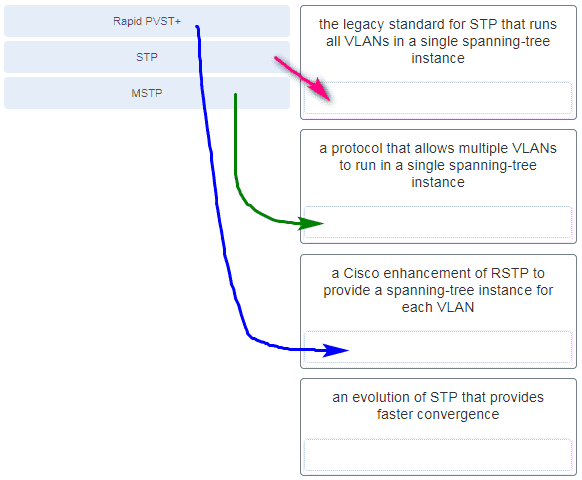
CCNA 2 v7.0 Modules 5 – 6 Exam Answers p6
7. In which two port states does a switch learn MAC addresses and process BPDUs in a PVST network? (Choose two.)
disabled
forwarding*
listening
blocking
learning*
8. If no bridge priority is configured in PVST, which criteria is considered when electing the root bridge?
lowest MAC address*
lowest IP address
highest IP address
highest MAC address
9. Match the spanning-tree feature with the protocol type. (Not all options are used.)
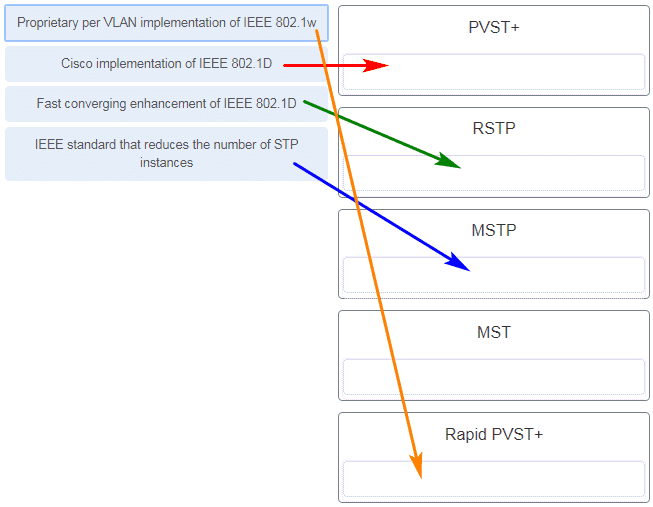
CCNA 2 v7.0 Modules 5 – 6 Exam Answers p9
10. When the show spanning-tree vlan 33 command is issued on a switch, three ports are shown in the forwarding state. In which two port roles could these interfaces function while in the forwarding state? (Choose two.)
alternate
designated*
disabled
blocked
root*
11. What is the function of STP in a scalable network?
It decreases the size of the failure domain to contain the impact of failures.
It protects the edge of the enterprise network from malicious activity.
It combines multiple switch trunk links to act as one logical link for increased bandwidth.
It disables redundant paths to eliminate Layer 2 loops.*
12. What is a characteristic of spanning tree?
It is enabled by default on Cisco switches.*
It is used to discover information about an adjacent Cisco device.
It has a TTL mechanism that works at Layer 2.
It prevents propagation of Layer 2 broadcast frames.
13. Which spanning tree standard supports only one root bridge so that traffic from all VLANs flows over the same path?
PVST+
802.1D*
MST
Rapid PVST
14. What is the purpose of the Spanning Tree Protocol (STP)?
creates smaller collision domains
prevents routing loops on a router
prevents Layer 2 loops*
allows Cisco devices to exchange routing table updates
creates smaller broadcast domains
15. What is the value used to determine which port on a non-root bridge will become a root port in a STP network?
the path cost*
the highest MAC address of all the ports in the switch
the lowest MAC address of all the ports in the switch
the VTP revision number
16. Refer to the exhibit.
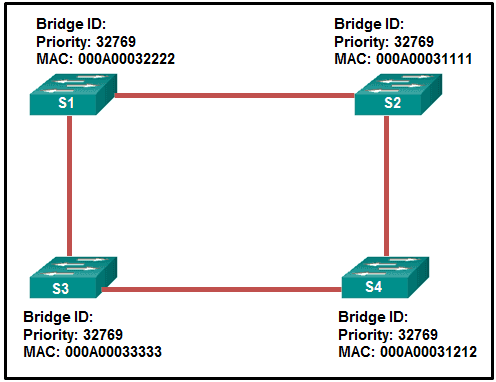
CCNA 2 v7.0 Modules 5 – 6 Exam Answers p16
Which switch will be the root bridge after the election process is complete?
S1
S2*
S3
S4
17. What are two drawbacks to turning spanning tree off and having multiple paths through the Layer 2 switch network? (Choose two.)
The MAC address table becomes unstable.*
The switch acts like a hub.
Port security becomes unstable.
Broadcast frames are transmitted indefinitely.*
Port security shuts down all of the ports that have attached devices.
18. A small company network has six interconnected Layer 2 switches. Currently all switches are using the default bridge priority value. Which value can be used to configure the bridge priority of one of the switches to ensure that it becomes the root bridge in this design?
1
28672*
32768
34816
61440
19. Refer to the exhibit.

CCNA 2 v7.0 Modules 5 – 6 Exam Answers p19
The administrator tried to create an EtherChannel between S1 and the other two switches via the commands that are shown, but was unsuccessful. What is the problem?
Traffic cannot be sent to two different switches through the same EtherChannel link.*
Traffic cannot be sent to two different switches, but only to two different devices like an EtherChannel-enabled server and a switch.
Traffic can only be sent to two different switches if EtherChannel is implemented on Gigabit Ethernet interfaces.
Traffic can only be sent to two different switches if EtherChannel is implemented on Layer 3 switches.
20. Which statement is true regarding the use of PAgP to create EtherChannels?
It requires full duplex.
It increases the number of ports that are participating in spanning tree.
It requires more physical links than LACP does.
It mandates that an even number of ports (2, 4, 6, etc.) be used for aggregation.
It is Cisco proprietary.*
21. What are two requirements to be able to configure an EtherChannel between two switches? (Choose two.)
All the interfaces need to work at the same speed.*
All interfaces need to be assigned to different VLANs.
Different allowed ranges of VLANs must exist on each end.
All the interfaces need to be working in the same duplex mode.*
The interfaces that are involved need to be contiguous on the switch.
22. Refer to the exhibit.
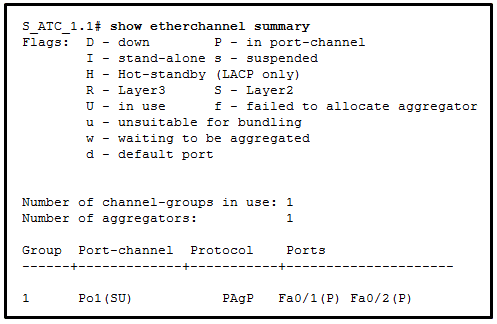
CCNA 2 v7.0 Modules 5 – 6 Exam Answers p22
On the basis of the output that is shown, what can be determined about the EtherChannel bundle?
The EtherChannel bundle is down.
Two Gigabit Ethernet ports are used to form the EtherChannel.
A Cisco proprietary protocol was used to negotiate the EtherChannel link.*
The EtherChannel bundle is operating at both Layer 2 and Layer 3.
23. Which two parameters must match on the ports of two switches to create a PAgP EtherChannel between the switches? (Choose two.)
port ID
PAgP mode
MAC address
Speed*
VLAN information*
24. Refer to the exhibit.
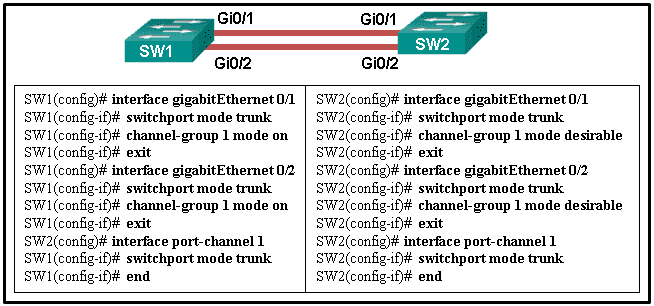
CCNA 2 v7.0 Modules 5 – 6 Exam Answers p24
A network administrator is configuring an EtherChannel link between two switches, SW1 and SW2. Which statement describes the effect after the commands are issued on SW1 and SW2?
The EtherChannel is established after SW2 initiates the link request.
The EtherChannel is established after SW1 initiates the link request.
The EtherChannel is established without negotiation.
The EtherChannel fails to establish.*
25. Refer to the exhibit.

CCNA 2 v7.0 Modules 5 – 6 Exam Answers p25
A network administrator is configuring an EtherChannel link between two switches, SW1 and SW2. However, the EtherChannel link fails to establish. What change in configuration would correct the problem?
Configure SW2 EtherChannel mode to desirable.*
Configure SW2 EtherChannel mode to on.
Configure SW1 EtherChannel mode to on.
Configure SW2 EtherChannel mode to auto.
26. A network administrator configured an EtherChannel link with three interfaces between two switches. What is the result if one of the three interfaces is down?
The remaining two interfaces continue to load balance traffic.*
The remaining two interfaces become separate links between the two switches.
One interface becomes an active link for data traffic and the other becomes a backup link.
The EtherChannel fails.
27. A network administrator is configuring an EtherChannel link between switches SW1 and SW2 by using the command SW1(config-if-range)# channel-group 1 mode auto . Which command must be used on SW2 to enable this EtherChannel?
SW2(config-if-range)# channel-group 1 mode passive
SW2(config-if-range)# channel-group 1 mode desirable*
SW2(config-if-range)# channel-group 1 mode on
SW2(config-if-range)# channel-group 1 mode active
28. Which technology is an open protocol standard that allows switches to automatically bundle physical ports into a single logical link?
PAgP
LACP*
Multilink PPP
DTP
29. What is a requirement to configure a trunking EtherChannel between two switches?
The allowed range of VLANs must be the same on both switches.*
The participating interfaces must be assigned the same VLAN number on both switches.
The participating interfaces must be physically contiguous on a switch.
The participating interfaces must be on the same module on a switch.
30. What are two advantages of using LACP? (Choose two.)
It allows directly connected switches to negotiate an EtherChannel link.*
It eliminates the need for configuring trunk interfaces when deploying VLANs on multiple switches.
It decreases the amount of configuration that is needed on a switch.
It provides a simulated environment for testing link aggregation.
It allows the use of multivendor devices.*
LACP allows Fast Ethernet and Gigabit Ethernet interfaces to be mixed within a single EtherChannel.
31. A switch is configured to run STP. What term describes a non-root port that is permitted to forward traffic on the network?
root port
designated port*
alternate port
disabled
32. What are two advantages of EtherChannel? (Choose two.)
Spanning Tree Protocol views the physical links in an EtherChannel as one logical connection.*
Load balancing occurs between links configured as different EtherChannels.
Configuring the EtherChannel interface provides consistency in the configuration of the physical links.*
Spanning Tree Protocol ensures redundancy by transitioning failed interfaces in an EtherChannel to a forwarding state.
EtherChannel uses upgraded physical links to provide increased bandwidth.
33. Refer to the exhibit.

CCNA 2 v7.0 Modules 5 – 6 Exam Answers p33
What are the possible port roles for ports A, B, C, and D in this RSTP-enabled network?
alternate, designated, root, root*
designated, alternate, root, root
alternate, root, designated, root
designated, root, alternate, root
34. Refer to the exhibit.
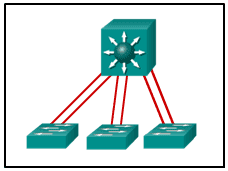
CCNA 2 v7.0 Modules 5 – 6 Exam Answers p34
Which switching technology would allow each access layer switch link to be aggregated to provide more bandwidth between each Layer 2 switch and the Layer 3 switch?
trunking
HSRP
PortFast
EtherChannel*
35. Refer to the exhibit.

CCNA 2 v7.0 Modules 5 – 6 Exam Answers p35
An administrator wants to form an EtherChannel between the two switches by using the Port Aggregation Protocol. If switch S1 is configured to be in auto mode, which mode should be configured on S2 to form the EtherChannel?
auto
on
off
desirable*
36. Open the PT Activity. Perform the tasks in the activity instructions and then answer the question.

CCNA 2 v7.0 Modules 5 – 6 Exam Answers p36
Which set of configuration commands issued on SW1 will successfully complete the EtherChannel link between SW1 and SW2?
interface GigabitEthernet0/1
no shutdown
interface Port-channel 1
no shutdown
interface GigabitEthernet0/2
channel-group 2 mode desirable
interface GigabitEthernet0/1
channel-group 1 mode desirable**
37. A set of switches is being connected in a LAN topology. Which STP bridge priority value will make it least likely for the switch to be selected as the root?
65535
4096
32768
61440*
38. In which two PVST+ port states are MAC addresses learned? (Choose two.)
Learning*
Forwarding*
disabled
listening
blocking
39. Which port role is assigned to the switch port that has the lowest cost to reach the root bridge?
designated port
disabled port
root port*
non-designated port
40. A switch is configured to run STP. What term describes the switch port closest, in terms of overall cost, to the root bridge
root port*
designated port
alternate port
disabled
42. A switch is configured to run STP. What term describes a field used to specify a VLAN ID?
extended system ID*
port ID
bridge priority
bridge ID
43. A switch is configured to run STP. What term describes the reference point for all path calculations?
root bridge*
root port
designated port
alternate port
44. A switch is configured to run STP. What term describes a field that has a default value of 32,768 and is the initial deciding factor when
electing a root bridge?
bridge priority*
MAC Address
extended system ID
bridge ID
45. Which statement describes an EtherChannel implementation?
EtherChannel operates only at Layer 2.
PAgP cannot be used in conjunction with EtherChannel.
A trunked port can be part of an EtherChannel bundle.*
EtherChannel can support up to a maximum of ten separate links.
46. Refer to the exhibit.
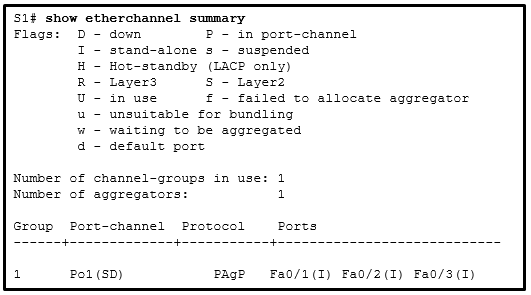
CCNA 2 v7.0 Modules 5 – 6 Exam Answers p46
A network administrator issued the show etherchannel summary command on the switch S1. What conclusion can be drawn?
The EtherChannel is suspended.
The EtherChannel is not functional.*
The port aggregation protocol PAgP is misconfigured.
FastEthernet ports Fa0/1, Fa0/2, and Fa0/3 do not join the EtherChannel.
47. Which statement describes a characteristic of EtherChannel?
It can combine up to a maximum of 4 physical links.
It can bundle mixed types of 100 Mb/s and 1Gb/s Ethernet links.
It consists of multiple parallel links between a switch and a router.
It is made by combining multiple physical links that are seen as one link between two switches.*
48. Which two channel group modes would place an interface in a negotiating state using PAgP? (Choose two.)
on
desirable*
active
auto*
passive
49. Which mode configuration setting would allow formation of an EtherChannel link between switches SW1 and SW2 without sending negotiation traffic?
SW1: on
SW2: on**
SW1: desirable
SW2: desirable
SW1: auto
SW2: auto
trunking enabled on both switches
SW1: auto
SW2: auto
PortFast enabled on both switches
SW1: passive
SW2: active
50. Refer to the exhibit.
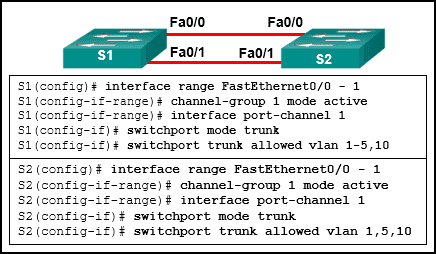
CCNA 2 v7.0 Modules 5 – 6 Exam Answers p50
An EtherChannel was configured between switches S1 and S2, but the interfaces do not form an EtherChannel. What is the problem?
The interface port-channel number has to be different on each switch.
The switch ports were not configured with speed and duplex mode.
The switch ports have to be configured as access ports with each port having a VLAN assigned.
The EtherChannel was not configured with the same allowed range of VLANs on each interface.*
51. When EtherChannel is configured, which mode will force an interface into a port channel without exchanging aggregation protocol packets?
active
auto
on*
desirable
52. What are two load-balancing methods in the EtherChannel technology? (Choose two.)
combination of source port and IP to destination port and IP
source IP to destination IP*
source port to destination port
combination of source MAC and IP to destination MAC and IP
source MAC to destination MAC*
53. Which protocol provides up to 16 instances of RSTP, combines many VLANs with the same physical and logical topology into a common RSTP instance, and provides support for PortFast, BPDU guard, BPDU filter, root guard, and loop guard?
STP
Rapid PVST+
PVST+
MST*
54. What is the outcome of a Layer 2 broadcast storm?
Routers will take over the forwarding of frames as switches become congested.
New traffic is discarded by the switch because it is unable to be processed.*
CSMA/CD will cause each host to continue transmitting frames.
ARP broadcast requests are returned to the transmitting host.
55. Which two network design features require Spanning Tree Protocol (STP) to ensure correct network operation? (Choose two.)
static default routes
implementing VLANs to contain broadcasts
redundant links between Layer 2 switches*
link-state dynamic routing that provides redundant routes
removing single points of failure with multiple Layer 2 switches*
56. A network administrator has configured an EtherChannel between two switches that are connected via four trunk links. If the physical interface for one of the trunk links changes to a down state, what happens to the EtherChannel?
Spanning Tree Protocol will transition the failed physical interface into forwarding mode.
Spanning Tree Protocol will recalculate the remaining trunk links.
The EtherChannel will transition to a down state.
The EtherChannel will remain functional.*


Julio
Colorear las tres respuestas de la pregunta
5. Which three components are combined to form a bridge ID?
extended system ID*
cost
IP address
bridge priority*
MAC address*
port ID
Las tres respuestas son MAC address, extended system ID y extended system ID.
Edward
Buenos días,
Se debe corregir:
48. Which two channel group modes would place an interface in a negotiating state using PAgP? (Choose two.)
on
desirable*
active
auto
passive*
Answers: desirable* and auto
The two PAgP modes known are desirable and auto. Passive is a LACP mode.
CisacadESP
Claro que si gracias por su colaboracion